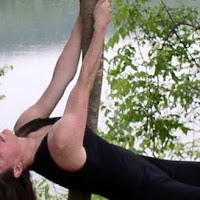The dark is pregnant with possibilities.
*
Many tell the Christmas story, and many of those tellings focus on the Christ child. He was conceived. He was carried. He is born. He lives, a divine Presence, with us.
Nevertheless, hidden within all those passive verbal constructions following his name is the one without whom he wouldn’t have happened: Mary.
For me, the Christmas story is about Mary.
Mary conceives. Whether you translate virgin as “young maiden” or “without sex,” the thrust of the story is the same. Young Mary needed no other human person to begin her journey into motherhood. The mother matter was between her and god, a purely personal relationship: god is with her, in her full bodily self, and she opens to say yes. Yes to desire. Yes to her self. My soul doth magnify the lord. Her innermost sensory self is where god will be grown.
 Mary carries. In saying yes to her god-self, she says yes to entering the darkness. She is pregnant for the first time. She is not wed. The outcomes are far from clear. Will she live? Will her bodily self know what to do? Will her baby live? Will she be shunned into eternal night? Or embraced by the arms of welcoming kin? How could her sparkling yes not be shrouded with fear, doubt, despair, and loneliness?
Mary carries. In saying yes to her god-self, she says yes to entering the darkness. She is pregnant for the first time. She is not wed. The outcomes are far from clear. Will she live? Will her bodily self know what to do? Will her baby live? Will she be shunned into eternal night? Or embraced by the arms of welcoming kin? How could her sparkling yes not be shrouded with fear, doubt, despair, and loneliness? Only Joseph is with her as they set out together for Bethlehem, leaving behind hearth and home, riding for miles, for hours, for days, nine months pregnant, on the back of a donkey. What sustains her through the taxing physical, emotional, spiritual ordeal?
Jesus, of course, moves in the darkness too, but his is a warm uterine wrap. He is along for a rhythmic ride, waiting for the waves of her contractions to wash him onto the sands of an air-born world. In her dark night, it is his movement within her that comforts her. He is alive. She can feel it. She has reason to believe.
Mary gives birth. She is waiting in a stable, dark and cold. Joseph is there, but what does he know about birth? What does she know? A sweet smell of coarse hay mixes with animal breath.
There, Mary labors. Wave after wave, she slowly opens to release the life in her. She gives birth to a curled infant, unbelievably small, who, however cry-free he may be, is helpless. He is completely dependent on her. She is the one who holds him, warms him, wipes him, and feeds him rich milk from her body.
He is present with her—and with us—because of what her body knows. She creates patterns of sensing and responding in relation to him that let him live, with her, with us.
*
The birth we celebrate at Christmas is more than a beginning. It is the end of a long journey in which Mary gives birth to herself as a birth-giver. She is the one who opens in the darkness, to the darkness, willing to conceive (of) a light that would not appear for months to come. She is the one who carries it as it quickens, and brings it forth, as a new life beginning. She is the one whose bodily movements enable him to live.
The movements she makes in conceiving, carrying, and birthing make her into someone who can and does participate consciously in the rhythms of her bodily becoming.
He is with us because of what her body knows.
*
There are times in all of our lives when darkness threatens to engulf us. Whether it is fear or anxiety, depression or despair, we wonder whether the light will ever return, or whether indeed, we will be dwell forever in eternal night.
It is to such moments that the Christmas story speaks. For we remember Mary. We remember her, in her bodily self, opening to sense and receive the quickening of new life in her.
With Mary, we affirm the creative power of our own bodily selves—a power to open to the movement of the divine in us, that is continuing to create and become, despite the darkness that overwhelms. When we open to this power, we will find the arms that embrace us, the relationships that sustain us, the Presence of light with us.
For our bodily selves were pulled into existence by the rhythm of light and dark, day and night, that enables all things to grow. As long as we breathe and beat and wake, that rhythm is alive in us. We can cultivate a sensory awareness of it, opening to receive the movements that are making us. We so participate in bringing into being a world we love that loves us.
The American dancer, Ruth St. Denis, wrote a poem called “Eternal Mary.” The last stanza is this: “We are all Mary/ Waiting to conceive/ And bear the Christ Child.”
This, for me, is the meaning of Christmas.
*
How did the story of a young woman delivering Presence morph into a tale about an old man delivering presents? It is a topic for another day.
Still, I wonder. Whose sack is it from which he pulls his gifts? Who remembers which child got which gift from year to year? Who gave him directions?
I suspect that if we want the full story, we will have to ask Mrs. Claus.

































